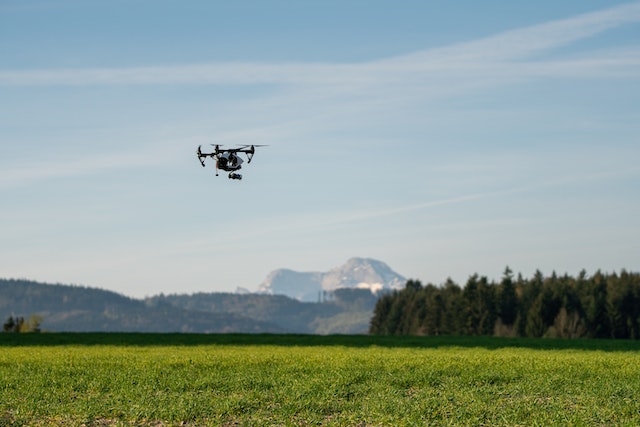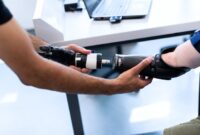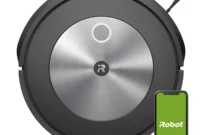Farming has come a long way over the centuries, from traditional manual labor to mechanized techniques. However, with the rapid advancements in technology, agriculture is now taking to the skies with the help of drones. These unmanned aerial vehicles are revolutionizing the farming industry by providing farmers with invaluable data and automation capabilities. In this article, we will explore the various ways drones are enhancing agriculture and revolutionizing farming practices.

The Rise of Drones in Agriculture
Over the past decade, drones have gained significant popularity and adoption in various industries. Agriculture, in particular, has witnessed a tremendous transformation with the integration of drone technology. Drones offer a cost-effective and efficient solution for farmers to monitor and manage their crops and livestock, leading to increased productivity and reduced operational costs.
Benefits of Using Drones in Farming
Increased Efficiency and Productivity
One of the primary advantages of using drones in farming is the improved efficiency and productivity they offer. Drones equipped with advanced imaging technology can quickly survey large areas of farmland, providing farmers with valuable insights into crop health, irrigation needs, and potential issues. This allows farmers to optimize their resources and make informed decisions promptly.
Precision Agriculture
Drones enable precision agriculture, which involves the precise management of crops based on specific field conditions. By collecting data on soil moisture, nutrient levels, and plant health, drones help farmers apply targeted interventions, such as precise irrigation and fertilization, resulting in optimal crop growth and yield.
Crop Monitoring and Health Assessment
Drones equipped with high-resolution cameras and sensors can capture detailed imagery of crops, allowing farmers to monitor their health and identify any signs of disease, nutrient deficiencies, or pest infestations. This early detection helps farmers take timely action, preventing the spread of diseases and minimizing crop losses.
Pest and Weed Management
Drones can also assist in pest and weed management by deploying targeted spraying mechanisms. By precisely targeting affected areas, farmers can minimize the use of pesticides and herbicides, reducing environmental pollution and optimizing resource utilization.
Reduced Environmental Impact
Traditional farming practices often involve the excessive use of fertilizers, water, and chemicals, which can have a detrimental impact on the environment. Drones, with their precise data collection capabilities, enable farmers to adopt more sustainable practices by minimizing the use of resources and reducing chemical applications.
Types of Agricultural Drones
To cater to the specific needs of farmers, several types of drones are available for agricultural purposes. These drones can be broadly classified into three categories: fixed-wing drones, multi-rotor drones, and hybrid drones.
Fixed-Wing Drones
Fixed-wing drones resemble small airplanes and are known for their efficiency in covering large areas. They are particularly useful for mapping and surveying extensive farmlands quickly.
Multi-Rotor Drones
Multi-rotor drones, commonly known as quadcopters, are the most popular type of drones in agriculture. They offer stability, maneuverability, and the ability to hover in place, making them suitable for close-up inspections and precision applications.
Hybrid Drones
Hybrid drones combine the advantages of both fixed-wing and multi-rotor drones. They can take off and land vertically like multi-rotor drones, but can also transition to fixed-wing flight for efficient coverage of large areas.
Drone Technology and Features for Agriculture
Drones used in agriculture are equipped with various technologies and features to maximize their effectiveness and usefulness on the farm.
GPS and Navigation Systems
GPS and navigation systems allow drones to follow pre-defined flight paths with high precision. This ensures accurate data collection and efficient coverage of the entire farmland.
Sensors and Imaging Technology
Drones are equipped with sensors and advanced imaging technology, including multispectral and thermal cameras. These sensors capture data that helps farmers assess crop health, identify areas of concern, and make data-driven decisions.
Data Collection and Analysis
Drones collect vast amounts of data during their flights. This data can be processed using specialized software to generate actionable insights, such as vegetation indices, plant count, and yield predictions. Advanced analytics help farmers optimize their operations and increase overall efficiency.
Automated Spraying Systems
Some agricultural drones are equipped with automated spraying systems that can precisely apply fertilizers, pesticides, or herbicides to specific areas. This feature minimizes wastage and ensures accurate application, reducing costs and environmental impact.
Regulations and Safety Considerations
While the adoption of drones in agriculture has numerous benefits, it also comes with regulatory and safety considerations that need to be addressed.
FAA Regulations
In many countries, including the United States, drone operations are regulated by aviation authorities such as the Federal Aviation Administration (FAA). Farmers and drone operators must comply with these regulations, which include obtaining appropriate licenses, adhering to flight restrictions, and maintaining safety standards.
Pilot Training and Licensing
Operating drones for commercial purposes often requires pilot training and licensing. This ensures that drone operators have the necessary skills to handle the equipment safely and responsibly.
Safety Precautions
Safety should always be a priority when using drones on the farm. Farmers must establish clear safety protocols, including maintaining safe distances from people, animals, and infrastructure. Regular maintenance and inspections of the drones are also crucial to ensure their safe operation.
Challenges and Limitations
While drones offer significant potential for enhancing agriculture, there are several challenges and limitations that need to be considered.
Cost and Investment
Acquiring drones and the associated equipment can involve a significant upfront investment. The cost of purchasing, maintaining, and operating drones may pose financial challenges for some farmers, especially small-scale operations.
Weather Conditions
Drones are sensitive to adverse weather conditions such as high winds, rain, or extreme temperatures. Poor weather can limit their flight capabilities and affect data collection. Farmers must plan their operations accordingly and consider alternative solutions during unfavorable weather conditions.
Data Privacy and Security
As drones collect large amounts of sensitive data, including imagery and geographical information, data privacy and security become critical concerns. Farmers must ensure that proper measures are in place to protect the data collected by drones and comply with privacy regulations.
Public Perception and Acceptance
The use of drones in agriculture is relatively new, and public perception and acceptance can vary. Farmers may need to educate and communicate with the local community about the benefits and safety measures associated with drone operations to address any concerns or misconceptions.
Future Prospects and Innovations
The future of drone technology in agriculture holds great promise. Several innovations and advancements are on the horizon, further expanding the capabilities of drones in farming.
Artificial Intelligence and Machine Learning
Artificial intelligence (AI) and machine learning algorithms can enhance the data analysis capabilities of drones. These technologies can automatically detect patterns, identify crop diseases, and provide real-time insights, empowering farmers to make data-driven decisions more efficiently.
Swarms of Drones
Swarms of drones working collaboratively can cover larger areas in less time. By sharing data and coordinating their actions, drone swarms have the potential to revolutionize the efficiency and scalability of agricultural operations.
Improved Battery Life and Range
Battery life and flight range limitations have been challenges for drone operations. However, ongoing advancements in battery technology are extending flight times and allowing drones to cover larger areas without interruptions.
Integration with Other Technologies
Drones can be integrated with other emerging technologies, such as Internet of Things (IoT) devices and satellite imaging. This integration enables seamless data exchange, improved remote sensing capabilities, and a holistic approach to farm management.
Case Studies: Successful Drone Applications in Agriculture
Let’s explore some real-world examples of how drones are being successfully used in agriculture:
Crop Dusting and Spraying
Drones equipped with spraying systems have been employed to apply fertilizers, pesticides, and herbicides more precisely and efficiently than traditional methods. This targeted approach minimizes chemical usage and reduces environmental impact.
Precision Crop Monitoring
Drones equipped with high-resolution cameras and multispectral sensors are used to monitor crop health and growth patterns. By capturing detailed imagery, farmers can identify areas of concern and take proactive measures to optimize crop yields.
Livestock Management
Drones can be used to monitor and manage livestock. They can help locate and count animals, inspect fences and infrastructure, and assess pasture conditions. This data allows farmers to make informed decisions regarding grazing management and animal welfare.
Irrigation and Water Management
Drones equipped with thermal cameras and soil moisture sensors aid in assessing irrigation needs and water management. By identifying areas with water stress or leakage, farmers can optimize irrigation practices, conserve water, and prevent yield loss.
Conclusion
Drones are transforming the agricultural landscape by providing farmers with valuable data, automation capabilities, and precision agriculture solutions. From crop monitoring and pest management to livestock management and irrigation optimization, drones are revolutionizing farming practices. As technology continues to advance and regulations evolve, drones are expected to play an increasingly integral role in enhancing agriculture and ensuring food security.
FAQs
1. Are drones legal to use in agriculture?
Yes, drones are legal to use in agriculture, but their operations are subject to regulations set by aviation authorities in different countries. Farmers and drone operators need to comply with these regulations and obtain the necessary licenses or permits.
2. How do drones help in reducing environmental impact?
Drones enable precision agriculture, which involves targeted interventions such as precise application of fertilizers and pesticides. By minimizing chemical usage and optimizing resource utilization, drones help reduce environmental pollution and promote sustainable farming practices.
3. Can drones be used for livestock management?
Yes, drones can be used for livestock management. They can assist in locating and counting animals, inspecting fences and infrastructure, and assessing pasture conditions. This data helps farmers make informed decisions regarding grazing management and animal welfare.
4. How do drones help in irrigation and water management?
Drones equipped with thermal cameras and soil moisture sensors can assess irrigation needs and identify areas with water stress or leakage. This information allows farmers to optimize irrigation practices, conserve water, and prevent yield loss.
5. What are the future prospects of drone technology in agriculture?
The future prospects of drone technology in agriculture are promising. Innovations such as artificial intelligence, drone swarms, improved battery life, and integration with other technologies will further enhance the capabilities of drones in farming, leading to increased efficiency and productivity.


